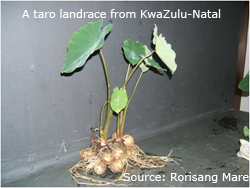Background
Taro (Colocasia esculenta (L.) Schott) is a traditional crop that has a potential to alleviate food insecurity,
 reduce poverty and create employment in the developing world. Taro is grown in a range of subtropical coastal
areas in South Africa, starting at Bizana district in the Eastern Cape and as far as the coastal area of KwaZulu-Natal.
The crop is also cultivated in the subtropical and tropical parts of Mpumalanga and Limpopo provinces. However, Umbumbulu,
an area close to the KwaZulu-Natal coast, where farmers are members of EFO (Ezemvelo Farmers Organisation), is the only area
in South Africa where subsistence farmers have been able to grow certified organic taro for the formal market.
Woolworths and Pick'n Pay sell the taro that the farmers produce in Durban, Cape Town and Johannesburg.
reduce poverty and create employment in the developing world. Taro is grown in a range of subtropical coastal
areas in South Africa, starting at Bizana district in the Eastern Cape and as far as the coastal area of KwaZulu-Natal.
The crop is also cultivated in the subtropical and tropical parts of Mpumalanga and Limpopo provinces. However, Umbumbulu,
an area close to the KwaZulu-Natal coast, where farmers are members of EFO (Ezemvelo Farmers Organisation), is the only area
in South Africa where subsistence farmers have been able to grow certified organic taro for the formal market.
Woolworths and Pick'n Pay sell the taro that the farmers produce in Durban, Cape Town and Johannesburg.
There is now an interest in processing taro into crisps, and this would provide more opportunities for
the marketing of taro. Farmers from inland areas are also becoming interested in growing taro in view of the
increasing popularity of taro as a cash crop. One problem is that 'dryland' or 'rainfed' taro (i.e. grown without irrigation)
does not grow in winter; consequently it is available for harvesting only from late February to early July. An additional problem is that taro has a short shelf-life.
|
 reduce poverty and create employment in the developing world. Taro is grown in a range of subtropical coastal
areas in South Africa, starting at Bizana district in the Eastern Cape and as far as the coastal area of KwaZulu-Natal.
The crop is also cultivated in the subtropical and tropical parts of Mpumalanga and Limpopo provinces. However, Umbumbulu,
an area close to the KwaZulu-Natal coast, where farmers are members of EFO (Ezemvelo Farmers Organisation), is the only area
in South Africa where subsistence farmers have been able to grow certified organic taro for the formal market.
Woolworths and Pick'n Pay sell the taro that the farmers produce in Durban, Cape Town and Johannesburg.
reduce poverty and create employment in the developing world. Taro is grown in a range of subtropical coastal
areas in South Africa, starting at Bizana district in the Eastern Cape and as far as the coastal area of KwaZulu-Natal.
The crop is also cultivated in the subtropical and tropical parts of Mpumalanga and Limpopo provinces. However, Umbumbulu,
an area close to the KwaZulu-Natal coast, where farmers are members of EFO (Ezemvelo Farmers Organisation), is the only area
in South Africa where subsistence farmers have been able to grow certified organic taro for the formal market.
Woolworths and Pick'n Pay sell the taro that the farmers produce in Durban, Cape Town and Johannesburg.